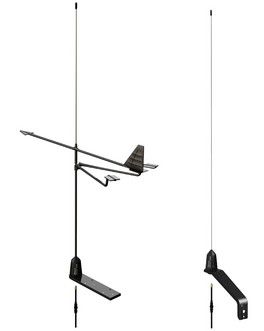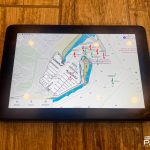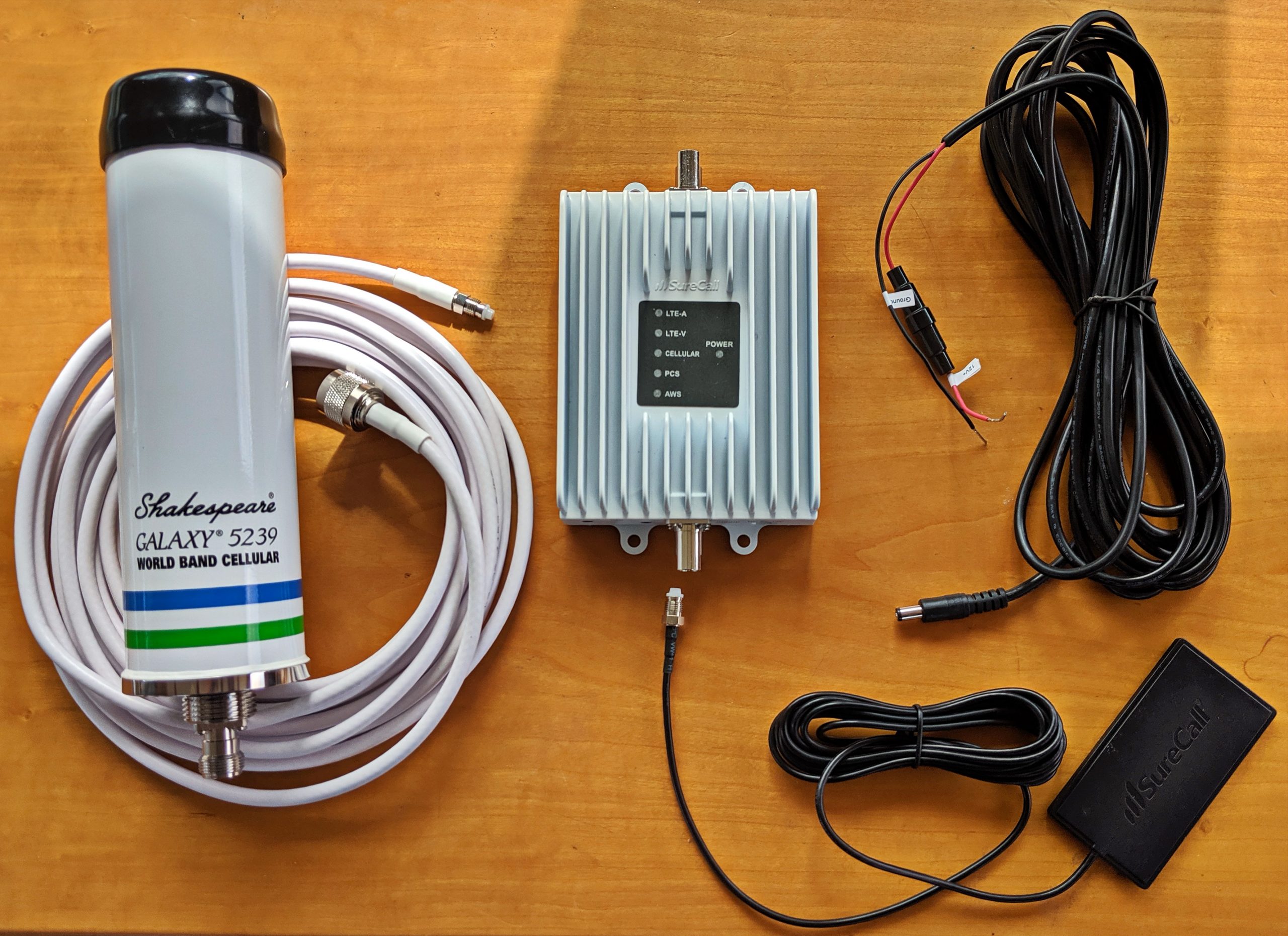Shakespeare sailboat VHF antennas, clever
These 3-foot, 3dB VHF whips look very smart for sailboat mast head installs, especially the Windex-style apparent wind direction indicator built into the $190 Galaxy 5440 model. Both it and the $160 5445 model come with 65 feet of RG-58 coax cable and an “exclusive solderless connector system” that enables easy removal of the whip, and also looks easier to fish up a mast than the standard PL-259 connector at the other end. Press release here.














Looks like it
– PRO: makes it significantly more difficult for birds to land and knock of the alignment of the aft two reference tabs.
– CON: raises the indicator a bit higher above the mast head lights, for night sailing it may no longer be visable for those boats that have a masthead light shining on it. Perhaps an adjustment fixes that.
Shakespeare should write a simple specification and allow VHF manufacturers to ride a few volts on the coax. Then put an LED up there for illumination at night. Since the VHF will know time from the GPS, it could be automated for dusk-to-dawn illumination or manually controlled.
This is pretty easy to do as it is done all the time with GPS, Loran, etc for pre-amp power.
This could also be a way to provide a mastlight/anchor light for any vessel as well without requiring another wire run.
Anon, if you’re going to the trouble of sending some volts up there for LED windex illumination (which sounds like a good idea) you’d probably want to include the tri/anchor as well. I always thought this would be a good use for N2K. But unfortunately unless they’re racers, no one cares about the extra cable.
Wouldn’t it be impossible to get something thru the FCC that would allow an open connection between the transmitter and antenna ?
Instead, perhaps
– Divide up the VHF radio into components so that the transmitter is mounted at the masthead and the antenna just screws in (now you get the whole 25 watts without any cable loss whatsoever)
– Add a lighting contoller to the masthead to power a tri color navigation light, anchor light, windex light, a steaming light, deck lights.
– Have a single NMEA-2000 wire go up the masthead, connect to both of the above plus NMEA-2000 compatible wind instrument
– Inside the boat connect the balance of what we think of as a VHF radio in a similiar form factor as what we have now (or make it a black box with command mic’s).
– Have some kind of a control panel for our lights that can turn them on and off.
– The lighting controller above would be unrelated to the VHF components, all the VHF manufacturer would be doing is providing an NMEA-2000 compatible way to have a remote transmitter/receiver connected and powered by NMEA-2000
Dan,
You are too hung up on NMEA2000. Your concept is simply not possible. Not only does NMEA2000 not have the bandwidth but, it would require a lot of remote, heavy, and unreachable hardware at the top of the mast. Not to mention about an 80 LEN (4 Amp) NMEA2000 VHF Tranceiver sensor! Lots of Cu, lots of complication, lots of loss, lots of money, and lots of failure potential when you really need it.
K.I.S.S. is the rule at the top of the mast. My concept obeys this tenant and would be no problem with the FCC.
Anon
Dan,
On the other hand……Sure, put an NMEA2000 port on the VHF, then allow an NMEA2000 command to control the voltage on the coax for whatever type of efficient LED light desired.
Running the vessel’s NMEA2000 backbone up a sailboat mast isn’t a great idea as far as I’m concerned. If there is more than one bacbone, like the Furuno concept I just read about in that IRIS, I’m OK with it.
Anon
A back of the envelope calculation has the transmit power dropping from 25 to 16 watts at the antenna due to coax loss, so your idea is not to be sniffed at. There’s also AIS and audio bandwidth/latency to be considered.
Dan – Great idea, but are you suggesting VoN2K (Voice Over NMEA-2000)? I think it’s going to need Ethernet as well.
Jon
Yes, voice over N2K (CANBUS). An automobile type module example:
http://www.ampltd.com/pc104/gsm-gps/locator-g3.html
At sampling rates appropriate for VHF, I believe it would use less than 10% of the bandwidth.
Ethernet – Not as elegant, although ethernet up the mast is already happening to support HD radar.
That’s an interesting little PC, Dan, but I think the CANbuses are only used for vehicle data, not voice.
These are not new antennas. Made in the UK by Communication Aerials for at least 15 years.
http://www.shakespeare-marine.com/news2.asp?release=48
In that CANBUS is designed for short messages, reliable delivery, has prioritization, and VHF is very low fidelity and one way at a time(imagine the compression opportunities !), I think it would make a great transport for a single voice channel. What do you need 4Khz for compressed voice? Because it’s one way at a time conversation, 15 packets per second?
I suspect that some car systems already use it to connect the phone used in telematics (e.g. call for help), this would use even less bandwidth.
Anon (I am still avail to help on your nmea 0183 issue) – the power for the transmitter would come from the single #12? power wire run up the mast for the lights, there would be no load on the NMEA-2000 except for the wind instrument.
Dan,
I still don’t get the advantage of your FrankenMast idea or the 0183 offer. I wasn’t trying to hijack this thread with super-hypothetical n2k conjecture that will only ever exist in your mind.
Instead, I was only suggesting one possibly simple and efficient way to see the index of these clever antennas at night in response to Ben’s concern.
Nmea 2k up the mast, are u crazy. Its a terrible system to begin with, Canbus was never designed for opened ended networking. Bus systems get very unstable and unreliable as they expand, its the reason ethernet went star. NMEA simply isnt able to technically manage a proper network design.
Ethernet would now be a far better standard to adopt.
Dave
Oy! I appreciate comments in general, but it would be good to stay vaguely on topic, which in this case is VHF masthead antennas.
Please use the Forums to go off on new subjects. And, Dave, you’re welcome to start a Forum topic about how terrible NMEA 2000 is, but note that a few shreds of actual evidence will help a lot to make your case.
Dave wrote “Nmea 2k up the mast, are u crazy”
🙂 crazy, me? I admit the transmitter on the masthead idea was spur of the moment (get all 25 watts instead of 16-17, whats not to like?), but the N2K at the masthead is not.
I use the optional built in terminator of the Airmar PB200 weather station / wind instrument, making the PB200 two feet above my 50 foot high masthead, one end of my N2K bus. If not already, it will soon be recognized as a best practice to install an N2K bus with one end at the masthead or ready to be extended there.
Follow Ben’s suggestion to bring the N2K/ethernet discussion to the forum, and I will be sure to comment.
In my past life I have done some electrical projects that were fairly ‘cleaver’ and in this role I needed a person who knew a lot about building electrical stuff.
A few months ago I suffered from the problem of too many things at the top of the mast and not enough separate power runs. My cleaver friend built me a black box for the top of the mast that did the following:
Turn on the power once – energized output A with 12V
Turn on-off-on the power quickly – energized output B with 12V (turned off A)
Turn on-off-on-off-on the power quickly – energized output C (turned off the other two)
It is a small black box that is potted and fully water / weather proof.
I use it for a masthead light on A, wireless camera on B (amazing the clarity you can get with a high aspect angle when looking ahead of the boat for reefs and such*), and hopefully in the future a neat wireless wind indicator on C.
He has three different colored LEDs pointing down on the bottom of the box so you can tell what device is turned on.
I have thought of other useful things to have at the masthead – wireless spot light, WiFi access point / repeater,
If we could get enough people interested, I am sure I could convince him to make up a few more of these for others. Let me know.
* Perhaps we should have everyone sign an agreement that they will ONLY use the masthead camera for legitimate navigational purposes and will keep it turned off when in port. 😉
Wouldn’t this work for someone who has a VHF at the masthead but not 12v wiring for an LED? Not sure if the voltage is reversible, but if it is, a OGM Tri-Anchor could be used to give a tri-color AND anchor without any additional wire! I don’t have a clue how big they are, or if they’re potted either…
(BTW, this is an SGC device, happened upon it when looking at an SSB tuner – I have no vested interest in SGC!)
DC Coaxial Line Isolator
This device allows up to 25VDC @ 1.5Amp to be supplied more than 150 feet via the RF transmission line to provide DC power to antenna couplers, antenna switches, pre-amplifiers or other DC powered equipment at the antenna end of the line, eliminating need of separate power cables to supply these devices. This compact unit measures 3 X 2 X 1.6 inches. Two isolators required per installation. Broadband Isolators provides better than 80Db isolation between the RF power on the coaxial feedline and DC power being remotely supplied on the same coaxial line. �RF In/Out to DC port isolation: Better than 80 Db, 1.5 MHz thru 30 MHz Better than 70 Db, 30 MHz thru 50 MHz Better than 40 Db thru and exceeding 250MHz RG-213 coaxial cable recommended for distances over 100 feet. Power supply for remoted equipment, not supplied. Price indicated is for two units as required for each installation.
$160.00